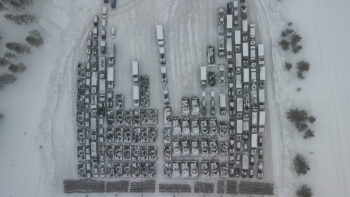AUSA: 15 years ago, when the Stryker entered Army service, traditionalist treadheads derided the eight-wheel-drive armored vehicle as far too light to fight alongside heavy tracked machines. Today, the Stryker is the middle-weight mainstay of the Army, filling a niche between light trucks like the Humvee and heavy tanks like the M1 Abrams. A big part of General Dynamics vehicle’s success is its versatility, with a wide array of variants in service and more on the way — two of them aimed particularly at countering Russian aggression in Eastern Europe.
The Army’s newest Stryker variant is the Dragoon, which replaces the traditional 12.7 mm machinegun mounting with a 30 mm autocannon. It was built in response to an urgent request from the Germany-based 2nd Cavalry Regiment — nicknamed the Dragoons — who felt outgunned by Russian mechanized divisions. While it can’t take on a tank, the 30 mm Stryker can shred lighter vehicles like BMP and BTR troop transports and provide heavy supporting fire for the infantry it carries.
General Dynamics is responding to another urgent need with its anti-aircraft variant of the Stryker, equipped with sensors and missiles to shoot down Russian helicopters and strike aircraft. (This model has no room left to carry troops). The Army’s not buying this version yet, but it’s a competitor for the Maneuver SHORAD (Short-Range Air Defense) initiative.
Army closing in on selecting new spy-plane integrator, user assessment around late-2026
HADES is “designed to support active campaigning short of conflict and then potentially support targeting in conflicted areas where you might let high-end stealthy fighters or unmanned systems take first contact,” said Andrew Evans, the ISR Task Force director.


























